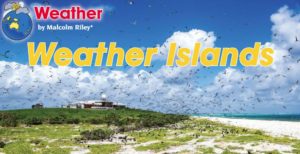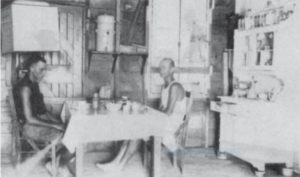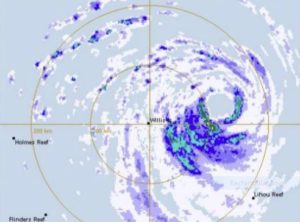- Author
- A.N. Other
- Subjects
- History - general
- Tags
-
- RAN Ships
- None noted.
- Publication
- March 2022 edition of the Naval Historical Review (all rights reserved)
By Malcolm Riley1
This article first appeared in the September 2020 edition of Afloat and is reproduced with the kind permission of the editor of that magazine and of the author.

Last month we looked at one of the most isolated islands on the planet. This month the focus is another isolated island, in the Coral Sea and part of Australian territory. Willis Island is located about 440 km east of Cairns and the only inhabitants are the staff that run the weather station. As with many islands, especially remote ones with small populations, they attract interesting characters and usually have abundant wildlife.
This weather station was set up in 1921 to give warnings of cyclones that could affect the Queensland coast. It is hard for us to comprehend, but in times past, cyclones would just turn up on the Queensland coast with little warning. In 1918, two severe tropical cyclones crossed the coast; one devastated Innisfail and the other Mackay. The government of the day thought a weather station in the Coral Sea would provide some warning of cyclones in the area. In the early days, Morse code messages that included air pressure, wind and temperature were transmitted back to Australia. As communications improved so did the frequency and type of weather readings. Today you can view real-time weather readings from Willis Island at http://www.bom.gov.au/products/IDQ60801/IDQ60801.94299 and radar pictures at http:// 111.bom.gov.au/products/IDR413.loop.shtml.
There are many automatic weather stations located on tiny sand islands and reefs off the Queensland coast. These remote, unmanned weather stations began to be built in the early 1970s with more added as time progressed, but for many years there was just Willis Island.
The Willis Island weather station turns 100 this year. June 2021 marks a century of habitation and November marks 100 years since the first telegraphed weather report. The weather station was set up by John King Davis, one of four people who went to a previously uninhabited island in 1921 to set up the weather station. Time spent on Willis Island varied from one year to six months; now the posting is sometimes three months. Davis was an interesting man; the Davis Sea and Australia’s Davis Base (Antarctica) are named after him. He was a sailor, explorer, scientist, adventurer and Mate and Captain of Shackleton’s vessel Nimrod.

At the outbreak of World War I, Davis volunteered for active service and became the Captain of the Australian troopship Boonah, originally a German ship seized at the outbreak of war. Boonah departed for Egypt from Western Australia in October 1918 with a full load of troops. They made it as far as Durban in South Africa when war ceased, and they were turned around for home.
Unfortunately, the crew and troops mixed with Durban dockworkers and caught the Spanish Flu, causing a few deaths during the Indian Ocean crossing back to Australia. Boonah became a plague ship and authorities would not let the majority of troops land in Fremantle.
Conditions on board were deplorable; bad food, cramped and being summer it was hot. There was a public outcry. A quote from a newspaper of the day reads: Enough of this inhuman incarceration of soldiers in the disease-stricken cubby-hole of a floating hell. The threat of already returned soldiers storming the vessel and freeing the soldiers helped the government change its mind and the troops were brought ashore. Post war, Davis became Captain of Discovery, taking Mawson’s team to Antarctica in 1929.
Life was tough on Willis Island in the early days. The duration of the staff posting was usually a year and there were very few visitors and little communication with the outside world. Small islands and isolation can bring their own version of cabin fever. Looking at the history and the stories I have heard, alcohol consumption was factor, and led to some interesting tales. To be fair, alcohol has played a huge role in Australian society for much of its history.
The steamer Morinda brought one of the new crews to the island in the late 1920s. The crew consisted of a radio operator and an offsider who acted as cook and general hand. The offsider was so drunk onboard the steamer he had to be lowered in a cargo net into the boat taking him ashore. Once onshore he was still so inebriated that he just sat amongst the stores on the beach, unable to move. Later on in the year it was noted that the offsider did not look well. Inspection of the storeroom found that all but two of the medicinal alcohol bottles were gone – drunk by the offsider. The remaining bottles were buried so the offsider could find them. The offsider would sometimes drink a mixture of sugar, yeast and water to ‘get a hit’ – not sure if this works though.
In my early days in the Bureau of Meteorology I was talking to a Willis Island veteran who was there in the late 40s – early 50s, and he related this story. The crew had run out or were running out of drinks, so they decided to make a batch of moonshine. They did, and it wasn’t too bad, so a session ensued. When they woke up the next morning they had hangovers of the like not had before, or since. Once they started functioning again they noticed that the date seemed to be wrong. They then figured out that they had been out of it for longer than 24 hours and had completely missed a day. Even today home brewing is practiced on the island but it is only beer – I believe they call it Guano Lager.

There were dangers to those living on the island. Cyclones can destroy and now, with warnings of impending cyclones, staff are evacuated – but not in times past, they must have hunkered down. During World War II, the Japanese were operating in the Coral Sea and the staff were nervous about their activity. However, the island was left alone. There is suspicion the Japanese cracked the weather code that was radioed out and were happy to keep receiving the weather observations.
During the 1960s and 1970s, giant clam fishermen came to the Great Barrier Reef from Asia, mainly Taiwan. These fishermen were pirating the fish and Queensland Fisheries in 1979 estimated about two million clams had been removed, all illegally. These fishermen were also held responsible for stripping anything of value from navigation equipment and automatic weather stations on remote islands. They would anchor off Willis Island and come ashore to ask for fresh water. Their visits worried the crews on the island, and at times they felt vulnerable. One staff member used to dress up in one lot of clothes, go outside and do something then come back in and change into different clothes, and then repeat this until his wardrobe was exhausted. His rationale was that those on the boats would think there were more people living on the island and be less likely to cause mischief. Through government efforts, including arrests by the Navy and jail time for the crews on the fishing boats, the trade ceased.
Isolation can do funny things to people; one crew consisted of a World War II veteran, a young guy and the boss. Theveteran used to keep the fishing gear in meticulous state whereas the young guy would fish and leave the gear in a poor state. Tensions rose. One day the boss heard a hell of a racket and went to investigate; the office was in a state of much disarray and had blood on the floor and there was a resignation letter on his desk from the young man. Trouble was, the boat was still six weeks away; those six weeks were not pleasant.
Nudity was also a common practice on the island. In the early days, with limited fresh water for washing clothes, some of the staff would go months without wearing a stitch apart from a hat and shoes. The end of this practice was probably when the mixed gender crews began to staff the island.
Many of the tales in this article are oral history and are at least 40-years-old. The world and Australia were different places back then. Over recent decades the staff at Willis Island have been professional in their duties and have shown great respect for the environment and the wildlife.
Notes:
- Malcolm Riley worked for the Bureau of Meteorology for 34 years and gives marine weather training to boating groups. He sails on tall ships in various parts of the world and skippers the Lady Nelson in Hobart.
- This most welcome article poses a number of questions: where is Willis Island on the map, who was Willis, and how is this an Australian possession, are just a few. Accordingly, we have decided to publish a follow-up story but readers will have to wait until the next edition of the Naval Historical Review.




